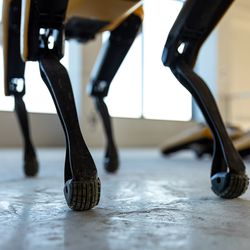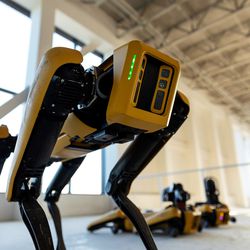Boston Dynamics’ Spot is leaving the laboratory
Boston Dynamics is letting its first major robot out of the lab.
Since June, the company has been talking about a public release for its Spot robot (formerly SpotMini), and today, it finally gave some details about what’s in store. The Spot isn’t going on sale exactly, but if you’re a company with a good idea (and some money), you’ll be able to get one. That also means, for the average person on the street, that the odds of seeing a Spot in the wild just got a lot better.
The capabilities are more or less what the company showed off in June, but it’s still impressive to see them in person. The Spot can go where you tell it, avoid obstacles, and keep its balance under extreme circumstances — which are all crucial skills if you’re trying to navigate an unknown environment.
The Spot can also carry up to four hardware modules on its back, giving companies a way to swap in whatever skills the robot needs for this particular job. If it’s checking for gas leaks, you can build in a methane detector. If you need connectivity over longer distances, you can attach a mesh radio module. Boston Dynamics is already outfitting units with LIDAR rigs from Velodyne (a favorite component for self-driving car projects) to create 3D maps of indoor spaces. Since the Spot is designed to work in the rain, outdoor spaces are on the table, too.
There are also the Spot’s dance moves, which usually come programmed into an offboard computing module. You might think the “Uptown Funk” routine was just PR, but entertainment is shaping up to be one of the biggest markets for the Spot. Boston Dynamics is already working with the innovation lab at Cirque du Soleil to see what it might be like to use the Spot onstage.
During our tests, we were instructed to stay two meters away from the Spot to keep from being pinched by its joints. We also gave it a wide berth when it was climbing stairs to make sure no one would be hurt if it lost its balance and fell. Both measures seemed to be more about Boston Dynamics being careful rather than the Spot being hazardous, but it’s a reminder that the robot simply wasn’t designed to interact with humans. For now, Boston Dynamics is focusing on uses in closed and controlled spaces, so it’s unlikely you’ll see a Spot wandering around your local mall anytime soon.
The company was also quick to say that it’s not interested in using the Spot as a weapon, despite the company’s military origins. “Fundamentally, we don’t want to see Spot doing anything that harms people, even in a simulated way,” says Michael Perry, VP of business development at Boston Dynamics. “That’s something we’re pretty firm on when we talk to customers.” (Boston Dynamics is still marketing to police departments, but it says the Spot would be limited to disposing of bombs and other hazardous materials, along the lines of existing police robots.)
The Spot is still a long way from anything like full autonomy, despite the impression you might get from the videos. One popular demo from last year shows the Spot opening a door by carefully turning the handle, pulling back the door, and propping it open with one leg to keep it from closing as the robot passed through. Some of the robotics researchers I talked to were fascinated by this demo: did it mean that the Spot could recognize doors, find handles and open them in the wild? Asked to navigate a path, would the Spot recognize which obstacles were walls and which were doors to be opened?
The real answer turns out to be simpler. The video shows the Spot’s “handle” protocol, which the controller initiates by navigating the claw toward the door and identifying the handle. Actually opening the door requires deft navigation of the physical forces involved, bracing the Spot’s body in a way that’s nearly impossible for a human operator to replicate — but it’s all athletic intelligence, not interpretive intelligence. The Spot isn’t in the business of recognizing doors or responding to cues from the physical world. In fact, the Spot’s model of the world around it is pretty shallow, consisting mostly of obstacles, footholds, and preprogrammed routes.
That’s the opposite of what many academic roboticists focus on, and Henny Admoni, who works on Human-Robot interaction at Carnegie Mellon University, told me it was an understandable but tricky trade-off. “Boston Dynamics has always been strong in mechanics and controls, like being able to shift the robot’s weight properly,” Admoni told me. “But robots operating in human environments won’t really have the option of avoiding humans. Integrating Human-Robot Interaction skills into development at an early stage is probably going to lead to greater success than trying to retrofit human interaction into existing systems.”
That’s not the path Boston Dynamics has taken, and the Spot’s interactions with human beings remain a major question mark for the project’s future. For now, the company is hoping that there’s enough work to do in human-free spaces.
Still, there’s a lot the Spot can do that simply wasn’t possible before, and it’s easy to see why Boston Dynamics is excited. The last 20 years have seen huge advances in automation, but it’s still largely confined to the digital world. If the platform takes off, the Spot could offer a new way for computer programs to interact with the physical world, a power that could have an enormous impact on technology and society at large. We’re still at the beginning of that process, but teaching a robot how to walk could turn out to be the most important step.
https://www.theverge.com/2019/9/24/20880511/boston-dynamics-spot-robot-mini-hands-on-lease-buy















